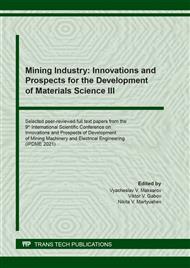p.3
p.13
p.21
p.28
p.41
p.48
p.54
p.60
Research of the Brittleness and Crack Resistance of Samples Made of Highly Hardened Silicon Carbide Ceramics
Abstract:
The paper presents a quantitative assessment of the brittleness of highly hardened silicon carbide ceramics. This characteristic is important for predicting the strength characteristics of the material. The analysis of existing methods for determining the brittleness of the material is carried out. During the research, it was assumed that the production of composite materials in the SiC-Al2O3 and SiC-Al2O3-AlN systems would combine high chemical resistance, wear resistance, and low coefficient of friction. These properties inherent in aluminum oxide and nitride, along with high thermal conductivity and strength, are characteristic of silicon carbide. Materials in the SiC-Al2O3 system containing 20, 50 and 80 percent of aluminum oxide – Al2O3 were selected as objects of research. Their advantages and disadvantages are shown. The results of an experimental study of samples made of highly hardened silicon carbide ceramics are presented. Based on experimental studies, analytical and graphical dependences are proposed that allow determining the crack resistance of ceramics from the crack length at the corners of the Vickers pyramid. It is shown that these dependences change exponentially, which makes it possible to predict the appearance of cracks at various stages of mechanical processing of products made of highly hardened ceramic materials.
Info:
Periodical:
Pages:
13-20
Citation:
Online since:
February 2022
Authors:
Price:
Сopyright:
© 2022 Trans Tech Publications Ltd. All Rights Reserved
Share:
Citation:


